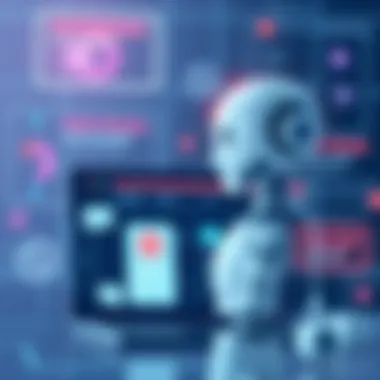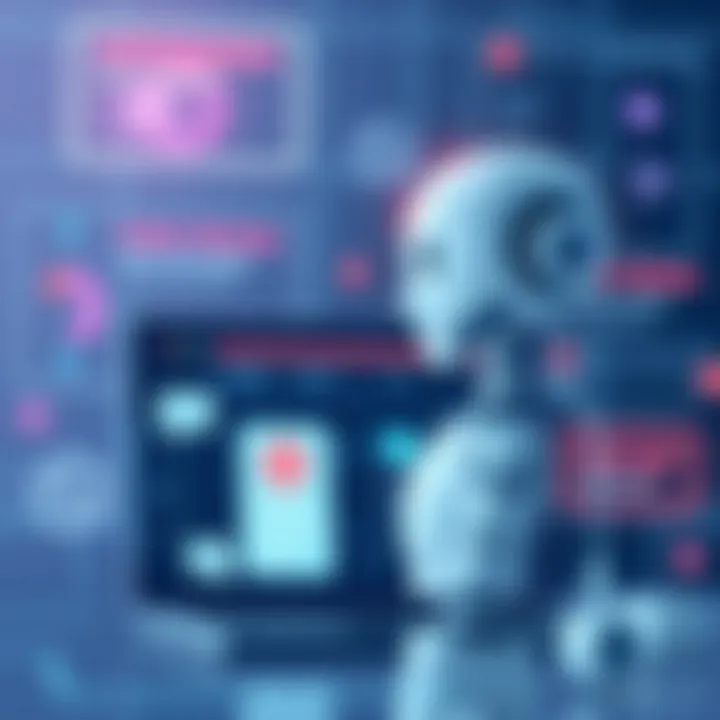Creating AI Chatbots: A Detailed Comprehensive Guide


Intro
Creating an effective AI chatbot involves careful planning and strategic execution. The journey begins with understanding the core capabilities that an AI chatbot can offer and ends with its deployment and continuous refinement. This guide intricately maps that route, considering not just the technical aspects but also the ethical implications of utilizing artificial intelligence in communication.
An AI chatbot acts as a digital interlocutor, bridging the gap between technology and human interaction. Depending on the objectives, the chatbot can serve in roles ranging from customer support to personal assistants.
In this guide, we aim to explore key elements such as:
- Understanding foundational concepts
- Strategic planning for deployment
- Ethical considerations faced by AI developers
- The ever-evolving trends in chatbot technology
By delving into these topics, readers will gain the insights necessary to build sophisticated chatbots that actually meet user needs, rather than just being flashy novelties.
Intro to AI Chatbots
The digital landscape is continuously evolving, and AI chatbots stand at the forefront of this shift. They provide businesses with unique opportunities to enhance user engagement, streamline communication, and improve response times. Their significance cannot be overstated in an age where instant gratification is the norm, and customers expect quick resolutions to their queries. But what makes chatbots so integral to modern customer service and interaction?
Chatbots serve multiple functions. They can be anything from simple scripts answering FAQs to sophisticated systems capable of engaging in dynamic conversations. Their adaptability is one of their strongest suits, catering to various sectors like retail, healthcare, and education. With such versatility, chatbots eliminate the long wait times that frustrate users, a key consideration for any organization looking to maintain a competitive edge.
In this section, we will explore what exactly constitutes an AI chatbot and trace its development from rudimentary systems to the advanced conversational agents we see today. This foundational understanding is essential for anyone aspiring to develop a chatbot or simply wishing to understand the strides made in this field.
What is an AI Chatbot?
An AI chatbot is a software application designed to simulate human-like conversations through text or voice interactions. Powered by Natural Language Processing (NLP) and machine learning, they analyze user inputs to generate meaningful responses. They can operate on various platforms, including websites, social media, and messaging applications, like Facebook Messenger and WhatsApp.
Think about it like this: if you have a question about your bank account, a chatbot might pop up on your banking app to assist you instantly. Without the need for human intervention, these systems access data and provide answers tailored to user inquiries. However, it's not just about providing answers; the best AI chatbots learn from interactions, adapting their responses over time to become increasingly effective.
To clarify further, here are some key traits that define AI chatbots:
- Conversational Ability: They mimic human-like dialogue, which can range from scripted responses to free-flowing, organic conversations.
- Learning Capability: Many chatbots use machine learning, allowing them to improve based on user feedback and interactions.
- Accessibility: Available 24/7, they ensure assistance is just a click away for users, enhancing overall customer satisfaction.
History and Evolution
The journey of AI chatbots began in the mid-20th century. Early attempts like ELIZA, developed in the 1960s at MIT, were basic rule-based systems focused mainly on mimicking conversation rather than understanding it. Although primitive by today's standards, ELIZA laid the groundwork for future developments in conversational AI. It did its best to engage users with programmed responses, which, while limited, sparked interest in creating more advanced systems.
Moving on to the 1990s, the likes of A.L.I.C.E and Chatbot emerged, further pushing the envelope with improved linguistic capabilities. But these innovations were still far from what we expect modern chatbots to achieve. As technology progressed into the 2000s, the introduction of machine learning and natural language processing led to a radical transformation. With advanced algorithms, newer chatbots became more intuitive and able to process larger amounts of data effectively.
Now, we find ourselves surrounded by a diverse array of chatbots capable of engaging in complex dialogues, anticipating user needs, and offering personalized experiences. Their significance has only multiplied due to the surge in user data and analytics, enabling developers to create bots that are not only reactive but also proactive in user engagement.


Understanding the Technology Behind Chatbots
Understanding the technology that underpins chatbots is crucial in developing effective systems that genuinely meet user requirements. Rather than mere trivia, this knowledge forms the foundation of successful chatbot creation, influencing not only how they interact with users but also how businesses integrate these solutions into their operations. With many chatbots now handling complex tasks, knowing the technology ensures one can effectively tackle challenges and leverage opportunities that arise.
Natural Language Processing
Natural Language Processing, or NLP for short, is often touted as the backbone of chatbot functionality. At its core, NLP involves the use of algorithms that help machines understand and interpret human language in a meaningful way. It’s like teaching a child how to interpret emotional tones in words or contextually understand sentences—this technology strives for similar feats but with data.
In practice, these large language models, through a series of linguistic methodologies, break down text into comprehensible components. They convert user input into structured data, which the chatbot can process further. This is where sentiment analysis, entity recognition, and intent detection come into play. For instance, if a user asks, “What’s the weather like in New York?” an effective chatbot must understand the intent behind this query to provide appropriate information quickly. But NLP does not stop there; it also continues to learn from interactions, becoming more proficient over time at correctly identifying nuances.
Importance of NLP in Chatbots
- User Engagement: An effective chatbot must engage users meaningfully, making NLP a key player here.
- Accuracy: A robust NLP engine provides the accuracy needed for better comprehension.
- Contextual Understanding: It ensures that bots maintain context through conversations, allowing for a more natural flow.
Ultimately, boasting strong NLP capabilities can set a chatbot apart in today’s competitive landscape.
Machine Learning Fundamentals
To make chatbots truly intelligent, machine learning is essential. Unlike basic programming, where outcomes are predefined, machine learning teaches systems to learn from experience, gradually improving performance over time. In the context of chatbots, this means that the more they interact with users, the better they adapt to unique dialogue patterns.
Training a chatbot entails feeding it vast datasets, which could include chat logs, books, articles, and more. This treasure trove of information helps the chatbot develop an understanding of human conversation, slang, and varied expressions, providing diverse communication styles. As the saying goes, if you give a man a fish, he'll eat for a day; if you teach a man to fish, he'll eat for a lifetime. This sums up the principle of machine learning fairly well: it’s about enabling ongoing learning, not just temporary fixes.
Benefits of Implementing Machine Learning
- Adaptive Responses: With every user interaction, a well-designed chatbot learns and offers increasingly relevant responses.
- Error Reduction: By recognizing previously misinterpreted input, it gradually reduces errors.
- Enhanced User Satisfaction: The responsiveness can greatly increase user satisfaction.
Conversational AI Frameworks
Conversational AI frameworks form the scaffolding upon which chatbots operate. These frameworks include various tools and services that enable developers to build, train, and deploy chatbots effectively. Important names in this space include Dialogflow, Microsoft Bot Framework, and IBM Watson, among others. Each offers unique features tailored to different development needs and environments.
These frameworks are vital because they provide the architecture to integrate machine learning capabilities and natural language processing. Think of it like the foundation of a house—without a strong base, the entire structure risks collapse. They streamline the complexities often tied to building a chatbot from scratch, facilitating smoother development processes.
Key Features of Popular Frameworks
- Pre-built Models: Many frameworks come with pre-trained models to jumpstart development.
- Support for Multiple Channels: They often allow deployment across various messaging platforms such as Facebook Messenger, WhatsApp, and websites.
- Analytics and Reporting: Most include tools to assess user interaction, helping developers adjust strategies accordingly.
Defining the Purpose of Your Chatbot
Defining the purpose of your chatbot is a critical step in the overall development process. It sets the tone for what your chatbot will achieve, who it will serve, and how it will function. By establishing a clear purpose, you ensure that every design and development decision aligns with the goals of both your business and your users. An unfocused chatbot can lead to confusion, frustration, and ultimately failure to engage users. This section discusses the elements that contribute to a well-defined chatbot purpose, its benefits, and the considerations to keep in mind.


Identifying User Needs
Understanding user needs is at the heart of defining your chatbot's purpose. What problems are users aiming to solve? What information or services do they seek? A thorough approach here can be game-changing. Start by gathering data through surveys, interviews, and observing user interactions with existing services. You might wonder why this matters. Well, when you comprehend your users, you can tailor your chatbot's responses to meet specific demands, making it far more useful.
For instance, if your primary audience is tech-savvy individuals looking for quick solutions or troubleshooting, your chatbot should be set up for effective, succinct interactions instead of lengthy explanations. Here are some steps to help in identifying user needs:
- Conduct Surveys and Interviews: Collect insights directly from your target audience.
- Analyze Support Tickets: Review past interactions to find common pain points.
- Utilize Analytics Tools: Use analytics from related platforms to understand behavior trends.
By aligning your chatbot's purpose with the actual needs of users, you pave the way for meaningful engagement.
Establishing Clear Objectives
Once you’ve grasped user needs, the next logical step is to establish clear objectives for your chatbot. The objectives should be Specific, Measurable, Achievable, Relevant, and Time-bound—often referred to as SMART. This clarity allows you to create a focused navigation system that channels users toward accomplishing their goals efficiently.
Let’s break it down further:
- Specific: Your objective should be clear and specific. For example, instead of saying "help users," you might say, "assist users in booking appointments online."
- Measurable: Establish how success will be measured. This could be through tracking the number of bookings made through the bot or user satisfaction ratings post-interaction.
- Achievable: Check if your goals are realistic given your resources and the target audience. You wouldn’t want to set yourself up for failure by aiming too high.
- Relevant: Make sure that your chatbot's objectives align with your business goals. If your business revolves around e-commerce, then facilitating purchases should be a key focus.
- Time-bound: You should set deadlines to evaluate the success of your chatbot and see if adjustments are required.
"A goal without a plan is just a wish."
Establishing these clear objectives not only guides the development process but also helps stakeholders understand the chatbot's role within the larger business strategy.
Ultimately, defining the purpose of your chatbot is not just about what it can do. It's about how well it can serve its users in a way that is seamless and beneficial for both parties. Keeping user needs and objectives at the forefront ensures that your chatbot serves a meaningful function, enhancing user experience and satisfaction.
Designing the Chatbot Experience
Designing a chatbot experience is not just about making it functional. It encompasses a holistic approach that combines understanding user behavior and crafting interactions that feel intuitive, engaging, and human-like. This phase is crucial as it lays the groundwork for how users perceive, interact with, and benefit from your chatbot. A well-designed experience can significantly enhance user engagement and satisfaction, while a poorly designed one can lead to frustration and abandonment. In this section, we will explore essential elements of designing a chatbot experience, focusing on creating user personas, mapping conversation flows, and considering interface design aspects.
Creating User Personas
Before diving into the nitty-gritty of your chatbot, it’s a smart move to define who your users are. This is where user personas fit in. These fictional characters represent segments of your target audience, embodying their needs, motivations, and behaviours. For instance, let’s say you are creating a chatbot for a banking institution. You might have different personas such as , a busy professional who values quick transactions; or , a retiree looking for assistance with financial planning.
By outlining diverse personas, you can better tailor the chatbot’s responses and features to meet various user needs. Each persona may require a unique conversational style. For example, Alice might prefer concise, efficient responses, whereas Bob might appreciate more detailed guidance. The more data you gather on your user personas, like their common queries or technology comfort levels, the more personalized and effective your chatbot will be.
Benefits of User Personas
- Targeted Design: Personas enable you to develop features that align closely with your users' preferences.
- Improved User Experience: Tailoring interactions fosters a sense of connection and satisfaction, reducing friction in user encounters.
- Data-Driven Insights: Gathering user data helps refine personas and improves the chatbot continually.
Mapping Conversation Flows


Once you've defined your user personas, the next step is to construct conversation flows. This process is akin to road mapping for the user journey through your chatbot. It illustrates how users will interact with the bot, guiding them from initiating contact to resolving their queries. Properly mapped conversation flows can help prevent users from getting lost or confused, which is paramount for maintaining engagement.
To start, list out typical user intents and construct potential responses. A flowchart can be an excellent visual tool in this stage. If we take Alice again, her flow might start with greetings, followed by prompts like
Selecting the Right Tools and Platforms
Choosing the right tools and platforms is a linchpin for effective chatbot development. With a growing array of software available on the market, navigating through these options can feel like looking for a needle in a haystack. The ideal tools not only streamline the development process but also align with your specific project objectives and user requirements.
When selecting tools, it’s essential to consider several factors like scalability, integration capabilities, and ease of use. You need resources that can grow with your chatbot or adjust to changing user demands. The right tools also facilitate smooth integration with existing systems, crucial for pulling relevant data and enhancing the user experience.
Moreover, understanding the nuances of different platforms allows you to weigh their strengths and weaknesses effectively. This can mean the difference between a chatbot that is a mere novelty and one that provides lasting value. If you're looking to create an engaging and functional AI assistant, then it’s non-negotiable to invest the time into choosing wisely.
Overview of Available Resources
The landscape of chatbot development tools ranges from development frameworks, platforms, to pre-built chatbot solutions. Here are some notable categories:
- Development Frameworks: These include libraries and tools designed to facilitate the coding process. Some well-known frameworks are Microsoft Bot Framework and Rasa.
- No-Code Platforms: Tools like Chatfuel or ManyChat allow those with little to no programming skills to create chatbots through a visual interface. This is particularly useful for businesses looking to deploy rapidly.
- Integration Platforms: Solutions like Zapier can help connect your chatbot to various applications and services, automating workflows.
- Analytics Tools: Monitoring chatbot performance is paramount. Tools like Google Analytics or Mixpanel are integral for gathering data and making informed decisions.
Choosing from these resources could feel overwhelming, but having clear objectives helps narrow your focus significantly. Always prioritize those that align most closely with your envisioned chatbot experience.
Criteria for Tool Selection
Selecting the right tool requires a thoughtful approach. Consider the following criteria:
- Functionality: Does the tool deliver the specific features your chatbot requires? Think about elements like natural language processing capabilities, multi-language support, and user engagement options.
- User Experience (UX): A tool that makes the development process intuitive can save countless hours. Look for drag-and-drop features or templates that can simplify the journey.
- Scalability: Will the tools you select allow your chatbot to grow as your needs evolve? Consider potential spikes in usage or the need for expanded functionalities in the future.
- Cost: Budget constraints are inevitable. Weight the costs against the features offered and look for a tool that provides good value for the investment.
- Community and Support: A strong developer community and customer support can drastically reduce debugging time and assist in optimizing your chatbot.
- Compatibility: Ensure the tool can integrate smoothly with your existing technical environment, including databases, APIs, and other software tools.
Selecting appropriate tools is not just about immediate needs; it’s about future-proofing your bot and ensuring it evolves alongside your business.
By digging deep into these considerations, you arm yourself with the knowledge needed to make an informed decision, setting your chatbot up for success from the start.
Developing the Chatbot
Creating an AI chatbot isn't just a matter of slapping together some code and calling it a day. It’s a meticulous process that requires a clear strategy and robust development skills. This phase is crucial because the way a chatbot interacts with users directly impacts its effectiveness and usability. The chatbot should be able to understand the users’ intents, facilitate meaningful conversations, and provide accurate responses to their queries.
By focusing on various components like logic coding, API integration, and thorough testing, developers can build chatbots that not only engage users but also continually learn and improve. For those who are serious about crafting a reliable AI chatbot, understanding each step in this development phase is paramount.
Coding the Chatbot Logic
At the heart of any AI chatbot is its coding logic. Think of this as the brain of your chatbot, the internal workings that define how it interprets user inputs and formulates responses. If the logic is solid, the chatbot performs seamlessly. If not, users could be left scratching their heads.
A common approach to writing the logic involves using languages such as Python or JavaScript. Here’s a simple code example to illustrate a basic response structure:
python
if user_input == "Hi":
response = "Hello! How can I assist you today?"
else:
response = "I'm not quite sure how to respond to that. Could you try again?"



